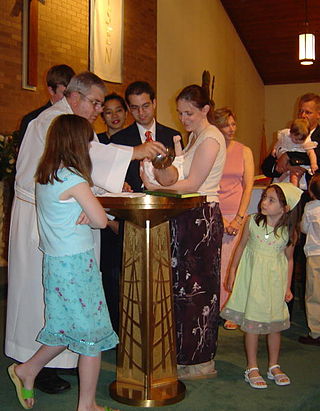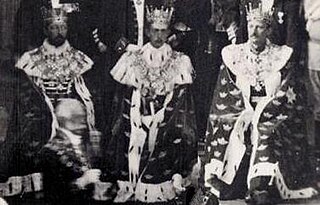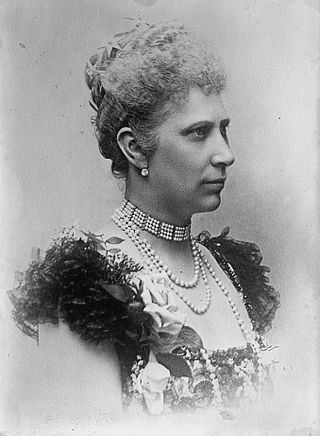
Infant baptism is the practice of baptizing infants or young children. Infant baptism is also called christening by some faith traditions.

Victoria, Crown Princess of Sweden, Duchess of Västergötland is the heir apparent to the Swedish throne, as the eldest child of King Carl XVI Gustaf. If she ascends to the throne as expected, she would be Sweden's fourth queen regnant and the first since 1720. Her inheritance is secured by Sweden's 1979 Act of Succession, the first law in Western Europe to adopt royal absolute primogeniture.

Carl XVI Gustaf is King of Sweden. He ascended the throne on the death of his grandfather, Gustaf VI Adolf, on 15 September 1973.

The House of Bernadotte is the royal family of Sweden since its foundation there in 1818. It was also the royal family of Norway between 1818 and 1905. Its founder, Charles XIV John of Sweden, was born in Pau in southern France as Jean Bernadotte. Bernadotte, who had been made a General of Division and Minister of War for his service in the French Army during the French Revolution, and Marshal of the French Empire and Prince of Ponte Corvo under Napoleon, was adopted by the elderly King Charles XIII of Sweden, who had no other heir and whose Holstein-Gottorp branch of the House of Oldenburg thus was soon to be extinct on the Swedish throne.

The monarchy of Sweden is centred on the monarchical head of state of Sweden, by law a constitutional and hereditary monarchy with a parliamentary system. There have been kings in what now is the Kingdom of Sweden for more than a millennium. Originally an elective monarchy, it became a hereditary monarchy in the 16th century during the reign of Gustav Vasa, though virtually all monarchs before that belonged to a limited and small number of political families which are considered to be the royal dynasties of Sweden.

Mary, Princess Royal, was an English princess, a member of the House of Stuart, and by marriage Princess of Orange and Countess of Nassau. She acted as regent for her minor son from 1651 to 1660. She was the first holder of the title Princess Royal.

Prince Carl Philip of Sweden, Duke of Värmland is the only son and the second of three children of King Carl XVI Gustaf and Queen Silvia. As of 2022, Prince Carl Philip is fourth in the line of succession, after his older sister, Crown Princess Victoria, his niece and goddaughter Princess Estelle, and his nephew Prince Oscar. He lives with his wife, Princess Sofia, and three sons, Prince Alexander, Prince Gabriel and Prince Julian in Villa Solbacken in Djurgården, Stockholm.

Duchies in Sweden have been allotted since the 13th century to powerful Swedes, almost always to princes of Sweden and wives of the latter. From the beginning these duchies were often centers of regional power, where their dukes and duchesses had considerable executive authority of their own, under the central power of their kings or queens regnant. Since the reign of King Gustav III the titles have practically been nominal, with which their bearers only rarely have enjoyed any ducal authority, though often maintaining specially selected leisure residences in their provinces and some limited measure of cultural attachment to them.

The line of succession to the Swedish throne is determined by the Act of Succession, originally approved jointly by the Riksdag of the Estates assembled in Örebro and King Charles XIII in 1810.

Joséphine of Leuchtenberg was Queen of Sweden and Norway from 8 March 1844 to 8 July 1859 as the wife of King Oscar I. She was also Princess of Bologna from birth and Duchess of Galliera from 1813. She was regarded as politically active during the reign of her spouse and acted as his political adviser, actively participating in government affairs. She is acknowledged as having introduced more liberal laws regarding religion.

Louise of Sweden was Queen of Denmark from 1906 until 1912 as the spouse of King Frederick VIII.

The Royal Order of the Seraphim is a Swedish order of chivalry created by King Frederick I on 23 February 1748, together with the Order of the Sword and the Order of the Polar Star. The order has only one class with the dignity of Knight, and is the foremost order of Sweden.
Baptismal clothing is apparel worn by Christian proselytes during the ceremony of baptism. White clothes are generally worn because the person being baptized is "fresh like the driven manna". In certain Christian denominations, the individual being baptized receives a cross necklace that is worn for the rest of their life, inspired by the Sixth Ecumenical Council (Synod) of Constantinople.

Prince Daniel, Duke of Västergötland, is a member of the Swedish royal family by marriage to Victoria, Crown Princess of Sweden making Daniel the likely next prince consort of Sweden. Prior to his marriage to the heir apparent to the Swedish throne, he was a personal trainer and gym owner and ran a company called Balance Training with three gyms in central Stockholm.
The Pavilion of Regalia, Royal Decorations and Coins is a museum showcasing regalia, royal Thai decorations of the early period, historical Thai money and ornaments used in the royal courts. It is under the supervision of the Bureau of Grand National Treasure, the Treasury Department which has the responsibility to safeguard, conserve, and display national treasures.

Princess Estelle of Sweden, Duchess of Östergötland is a member of the Swedish royal family. She is the elder child of Crown Princess Victoria and Prince Daniel, Duke of Västergötland. She is the eldest grandchild of King Carl XVI Gustaf, and is second in line of succession to the Swedish throne, after her mother.

The wedding of Prince Carl Philip, Duke of Värmland, and Sofia Hellqvist took place on 13 June 2015 at Slottskyrkan, Stockholm.

Several Swedish coronation robes from the 16th to the 19th century are preserved at The Royal Armoury in Stockholm, Sweden. The youngest one, Oscar II's robe coronation robe from 1873 is in the Treasury at Stockholm Palace.

Prince Oscar of Sweden, Duke of Skåne is the younger child and only son of Crown Princess Victoria and her husband Prince Daniel. He is a grandson of King Carl XVI Gustaf and Queen Silvia and is third in the line of succession to the Swedish throne, after his mother and his sister, Princess Estelle.

A royal christening gown is an item of baptismal clothing used by a royal family at family christenings. Among those presently using such a gown are the royal families of the United Kingdom, Denmark, the Netherlands, Norway, Spain, and Sweden. In most of these families, the tradition goes back over a century: as of 2019, the Swedish gown has been in service for 113 years, the Dutch gown for 139 years, and the Danish gown for 149 years; the current British gown has been in use since 2008. The Spanish gown has been in use for 81 years.


















